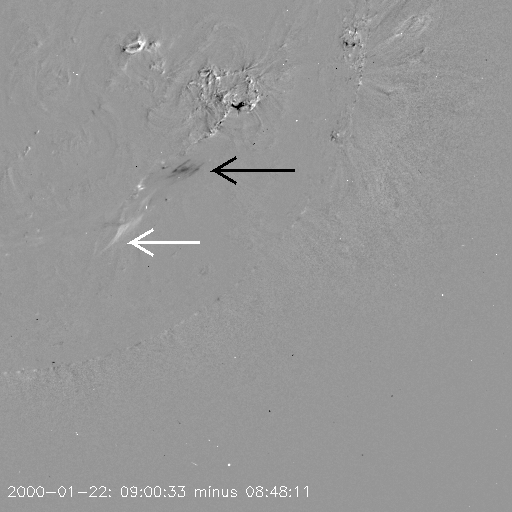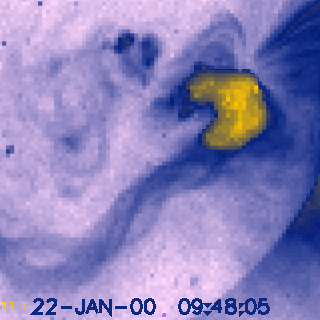Lighting up a filament channel
Science Nugget: October 13, 2000
Introduction
Filament channels are the large-scale coronal features that provide
the support of a filament (if seen on the disk) or prominence (if seen on
the limb) against gravity. A filament is cold and dense and has no right
to be floating high up in the corona - thus magnetic levitation with a
hotly-debated geometry is required. We have not done many weekly science
nuggets on filament channels, and in fact this research subject moves much
more slowly than it should. However with the "chewy
nougat" observation we found that one could sometimes see the cores of
filament channels as hot, rather than cool, coronal
inclusions -- there are also wonderful pictures from TRACE showing a
hot shroud of material around one of these cold inclusions in the corona.
Upon writing up the "chewy nougat," we found a convenient theory due to
Antiochos and Klimchuk: siphon flow that elevates chromospheric material
against the strong solar gravity (fifty times that of Earth at their
respective surfaces). Coronal siphons had seemed necessary theoretically
for some time, but the new wrinkle of this theory was that an energy
source needed to be found near the footpoint of a long coronal field line.
A filament channel contains such field lines - we know this because a
concave-up segment would be needed to support the cold prominence
material, or otherwise it would slide right down the field lines and drain
out of the corona.
The FlareGenesis opportunity
The flight of the polar-circling balloon carrying the
"FlareGenesis" telescope provided Yohkoh with some
opportunities for joint observations not only with the high-resolution
optical telescope/magnetograph on the balloon, but also with TRACE and
other resources for solar observation. The observation described in this
nugget resulted from this opportunity. A nice
M-class solar flare occurred in the balloon's (and therefore
everybody's) target active region. A review of the Yohkoh SXT
movie for a few days around this flare showed something interesting: the
flare apparently caused a brightening to spread along the length of the
filament channel. Moreover this transient brightening, or quite similar
ones, occurred half a dozen times in the same location while it was
visible on the solar disk, including a pair of brightening events that
occurred before the M flare.
The spine brightens!
The image above shows the channel we're talking about. In the left-hand
frame, the SXT image from 22-JAN-00, 05:48:19 UT, is shown with dashed
lines outlining the approximate location of the filament channel
boundaries. The right-hand panel shows the appearance of the same region
just 4 hours later: the difference should be obvious. But because we like
to show lots of pretty pictures in these Nuggets, an SXT movie is linked
below. The images span the interval 05:48 to 23:20 UT on 22-JAN-00.
The second brightening is during the aftermath of the M flare.
As one can see, the coronal loops along the length of the channel brighten
in X-rays, implying that either heat or hot plasma is injected into those
loops. The fact that this recurs several times over the course of a few
days (only two episodes are depicted here) indicates that the event must
not be too uncommon, and the flux tubes lying along that dimension of the
filament channel must be fairly stable. Please note that after the loops
brighten, they appear to stay hot for a few hours; this will be discussed
below.
Do the flux tubes in question lie along the center of the filament
channel, threading its axis like the "chewy nougat" phenomenon? Or do
they lie on the outside, as part of the shell of field lines closing
around the channel (like the X-ray image in the earlier
nugget)? From this viewing angle it is difficult to know for sure,
and risky to speculate, but either geometry requires the heating event to
affect the entire length of the channel without catastrophically
disrupting the magnetic stability. (Sound
familiar?)
And in this corner...
Just for fun, let's look at the same channel-brightening event in SOHO/EIT
images. The movie below provides the 195-Angstrom images from EIT,
between 08:24 and 15:36 UT; the temperature of the plasma shown here is
mostly
close to 1.5 million kelvins. We can see a small "front" of brightness
enhancement, propagating down the length of the channel, but the coronal
loops sure don't stay bright, like they do in SXT.
The transient nature of the brightening is the difference image below:
this shows the frame of 09:00:33 minus 08:48:11. The bright, wedge-shaped
feature (lower arrow) has brightened in the intervening 12 minutes, while
the rest of the loops north of that bright wedge have faded (particularly
the dark smudge indicated by the upper arrow).
 A JavaScript movie of these difference images is linked here
A JavaScript movie of these difference images is linked here
Why the difference?
Clearly there's something different about the images. We must recall that
SXT is a broadband instrument, and as such it shows plasma over a
wide range of temperatures, from about 2 to 20 million kelvins. This is
in contrast to EIT, which is a narrowband instrument: the
195-Angstrom channel is sensitive to 1.5-MK plasma, and not much else. So
one (un-refereed) interpretation is that the loops are heated from the
northwest end, and each EIT image is merely showing us that plasma which
happens to be at 1.5 MK at that time. Thus the propagating
brightness enhancement seen in the EIT images tracks the progress of
heating from one end of the channel to the other.
What does this have to do with the filament-creation theory mentioned
above? Possibly nothing. They're both related to heat sources near the
footpoints of long field lines, but the Antiochos & Klimchuk heating
source was not described as so episodic as the brightenings we're
monitoring here. Nonetheless, the observations would support the general
plausibility of the mechanism they envisioned. And perhaps there is a
connection to the "chewy nougats" -- hot, X-ray emitting cores which are
sometimes observed inside otherwise dark filament cavities. Again, those
brightenings are often less episodic than the current observations; but
variations in the X-ray brightness of nougats have certainly been
measured.
October 13, 2000
David McKenzie
<mckenzie@isass0.solar.isas.ac.jp>
Hugh Hudson
<hudson@isass0.solar.isas.ac.jp>






